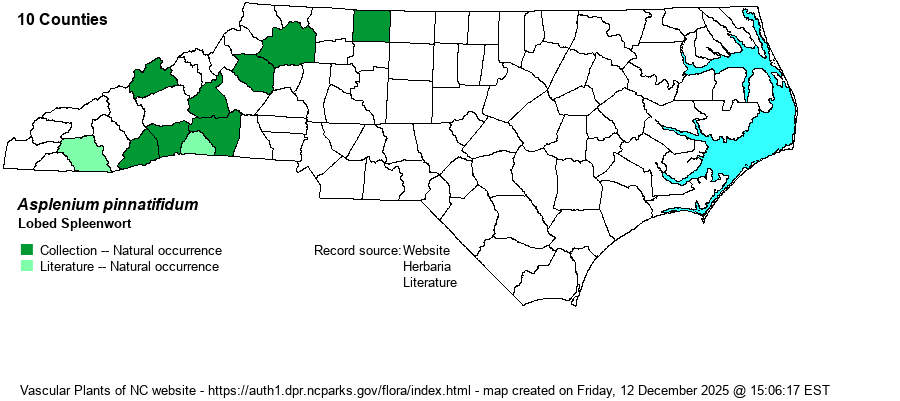| Author | Nuttall | |
| Distribution | Present in the Mountains, but mainly along the Blue Ridge Escarpment, and scarce farther westward toward the TN state line. A few western Piedmont records from outlier ranges. Thus, it occurs mainly at elevations between 1500 and 3000 feet.
This is an Eastern and Mideastern species with some odd disjunctions in the range. It occurs from NJ and southern WI south to central GA and eastern OK, and is scarce in the higher elevations of the Appalachians.
| |
| Abundance | Rare along and close to the Blue Ridge Escarpment, but very rare to absent elsewhere in the Mountains and western Piedmont. The NCNHP database contains 19 records, of which about 14 are still considered extant. This is a Significantly Rare species. | |
| Habitat | This rock-inhabiting fern grows only on felsic rocks, such as schists and sandstone, generally sedimentary or low-grade metamorphic ones. It grows in cracks and crevices on mostly vertical or near-vertical faces, in both exposed sites as well as rather shaded and damp ones -- favoring the drier sites. | |
| Phenology | Fruits from May to October. | |
| Identification | This is an oddly shaped fern, looking halfway between the lacy A. montanum and the lance-shaped A. rhizophyllum -- in fact, it indeed is a fertile allotetraploid species derived from the hybridization of these two species. Several fronds grow in a clump, with the usually dark brown stipe about 3-4 inches long, and a narrowly triangular blade about 7-8 inches long but barely 1 inch wide at the base. The evergreen blade is clearly pinnate-divided along the basal third to half of the blade, but the more distal half has the pinnae extremely short and barely just slight lobes along the rachis, with the distal end being very long and extremely slender. These lower pinnae are opposite and somewhat rounded in shape. There are several sori under each pinna, arranged diagonally to the midrib. Though Weakley (2018) does not list varieties, this species can be somewhat variable in blade shape; thus, you may find plants that do not look halfway between A. montanum and A. rhizophyllum in blade shape. | |
| Taxonomic Comments | None
| |
| Other Common Name(s) | Pinnatifid Spleenwort | |
| State Rank | S2 | |
| Global Rank | G4 | |
| State Status | SR-P | |
| US Status | | |
| USACE-agcp | | |
| USACE-emp | | |

